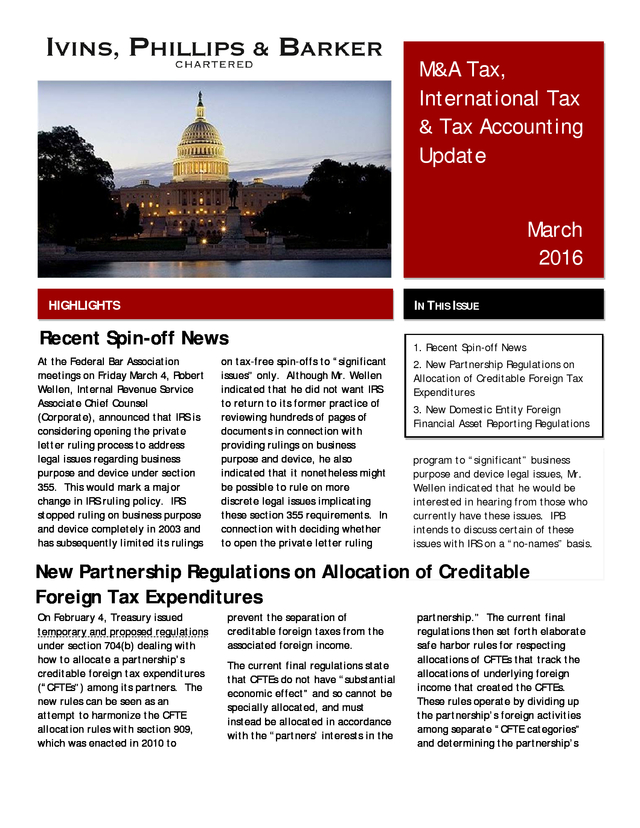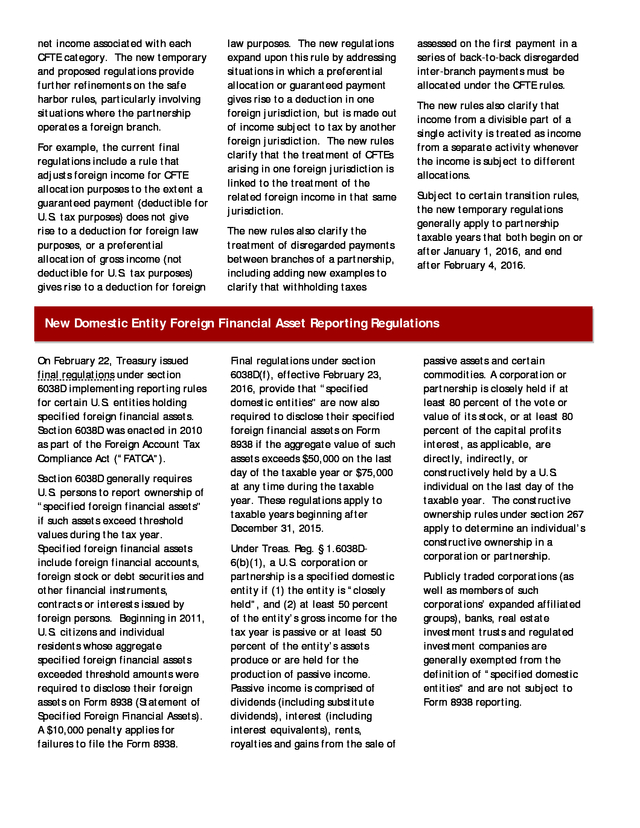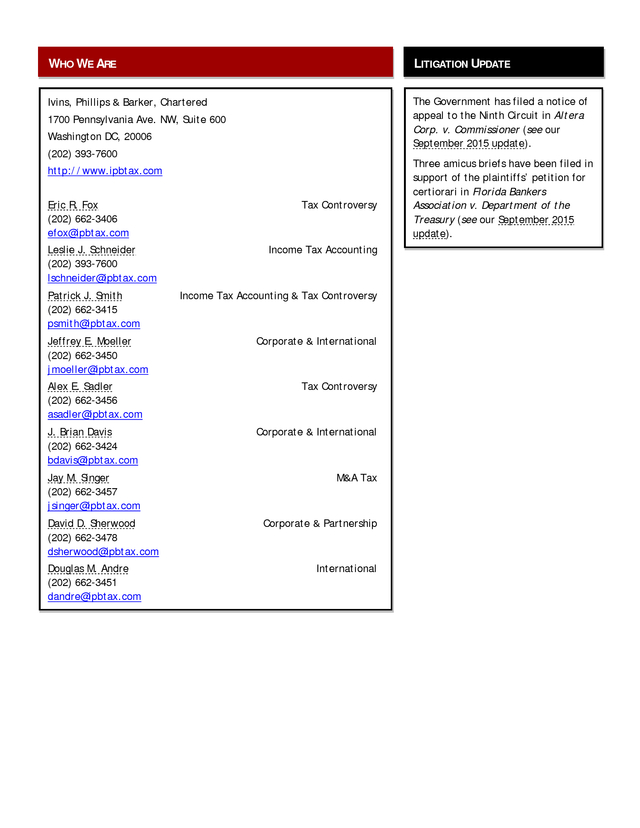Recent Spin-off - M&A Tax, International Tax & Tax Accounting Update for March 2016 – March 2016
Ivins, Phillips & Barker, Chartered
Description
M&A Tax,
International Tax
& Tax Accounting
Update
March
2016
HIGHLIGHTS
IN THIS ISSUE
Recent Spin-off News
At the Federal Bar Association
meetings on Friday March 4, Robert
Wellen, Internal Revenue Service
Associate Chief Counsel
(Corporate), announced that IRS is
considering opening the private
letter ruling process to address
legal issues regarding business
purpose and device under section
355. This would mark a major
change in IRS ruling policy. IRS
stopped ruling on business purpose
and device completely in 2003 and
has subsequently limited its rulings
1. Recent Spin-off News
on tax-free spin-offs to “significant
issues” only.
Although Mr. Wellen indicated that he did not want IRS to return to its former practice of reviewing hundreds of pages of documents in connection with providing rulings on business purpose and device, he also indicated that it nonetheless might be possible to rule on more discrete legal issues implicating these section 355 requirements. In connection with deciding whether to open the private letter ruling 2.
New Partnership Regulations on Allocation of Creditable Foreign Tax Expenditures 3. New Domestic Entity Foreign Financial Asset Reporting Regulations program to “significant” business purpose and device legal issues, Mr. Wellen indicated that he would be interested in hearing from those who currently have these issues. IPB intends to discuss certain of these issues with IRS on a “no-names” basis. New Partnership Regulations on Allocation of Creditable Foreign Tax Expenditures On February 4, Treasury issued temporary and proposed regulations under section 704(b) dealing with how to allocate a partnership’s creditable foreign tax expenditures (“CFTEs”) among its partners.
The new rules can be seen as an attempt to harmonize the CFTE allocation rules with section 909, which was enacted in 2010 to prevent the separation of creditable foreign taxes from the associated foreign income. The current final regulations state that CFTEs do not have “substantial economic effect” and so cannot be specially allocated, and must instead be allocated in accordance with the “partners’ interests in the partnership.” The current final regulations then set forth elaborate safe harbor rules for respecting allocations of CFTEs that track the allocations of underlying foreign income that created the CFTEs. These rules operate by dividing up the partnership’s foreign activities among separate “CFTE categories” and determining the partnership’s . net income associated with each CFTE category. The new temporary and proposed regulations provide further refinements on the safe harbor rules, particularly involving situations where the partnership operates a foreign branch. For example, the current final regulations include a rule that adjusts foreign income for CFTE allocation purposes to the extent a guaranteed payment (deductible for U.S. tax purposes) does not give rise to a deduction for foreign law purposes, or a preferential allocation of gross income (not deductible for U.S. tax purposes) gives rise to a deduction for foreign law purposes.
The new regulations expand upon this rule by addressing situations in which a preferential allocation or guaranteed payment gives rise to a deduction in one foreign jurisdiction, but is made out of income subject to tax by another foreign jurisdiction. The new rules clarify that the treatment of CFTEs arising in one foreign jurisdiction is linked to the treatment of the related foreign income in that same jurisdiction. The new rules also clarify the treatment of disregarded payments between branches of a partnership, including adding new examples to clarify that withholding taxes assessed on the first payment in a series of back-to-back disregarded inter-branch payments must be allocated under the CFTE rules. The new rules also clarify that income from a divisible part of a single activity is treated as income from a separate activity whenever the income is subject to different allocations. Subject to certain transition rules, the new temporary regulations generally apply to partnership taxable years that both begin on or after January 1, 2016, and end after February 4, 2016. New Domestic Entity Foreign Financial Asset Reporting Regulations On February 22, Treasury issued final regulations under section 6038D implementing reporting rules for certain U.S. entities holding specified foreign financial assets. Section 6038D was enacted in 2010 as part of the Foreign Account Tax Compliance Act (“FATCA”). Section 6038D generally requires U.S.
persons to report ownership of “specified foreign financial assets” if such assets exceed threshold values during the tax year. Specified foreign financial assets include foreign financial accounts, foreign stock or debt securities and other financial instruments, contracts or interests issued by foreign persons. Beginning in 2011, U.S. citizens and individual residents whose aggregate specified foreign financial assets exceeded threshold amounts were required to disclose their foreign assets on Form 8938 (Statement of Specified Foreign Financial Assets). A $10,000 penalty applies for failures to file the Form 8938. Final regulations under section 6038D(f), effective February 23, 2016, provide that “specified domestic entities” are now also required to disclose their specified foreign financial assets on Form 8938 if the aggregate value of such assets exceeds $50,000 on the last day of the taxable year or $75,000 at any time during the taxable year.
These regulations apply to taxable years beginning after December 31, 2015. Under Treas. Reg. § 1.6038D6(b)(1), a U.S.
corporation or partnership is a specified domestic entity if (1) the entity is “closely held”, and (2) at least 50 percent of the entity’s gross income for the tax year is passive or at least 50 percent of the entity’s assets produce or are held for the production of passive income. Passive income is comprised of dividends (including substitute dividends), interest (including interest equivalents), rents, royalties and gains from the sale of passive assets and certain commodities. A corporation or partnership is closely held if at least 80 percent of the vote or value of its stock, or at least 80 percent of the capital profits interest, as applicable, are directly, indirectly, or constructively held by a U.S. individual on the last day of the taxable year. The constructive ownership rules under section 267 apply to determine an individual’s constructive ownership in a corporation or partnership. Publicly traded corporations (as well as members of such corporations’ expanded affiliated groups), banks, real estate investment trusts and regulated investment companies are generally exempted from the definition of “specified domestic entities” and are not subject to Form 8938 reporting. .
WHO WE ARE LITIGATION UPDATE Ivins, Phillips & Barker, Chartered The Government has filed a notice of appeal to the Ninth Circuit in Altera Corp. v. Commissioner (see our September 2015 update). 1700 Pennsylvania Ave. NW, Suite 600 Washington DC, 20006 (202) 393-7600 http://www.ipbtax.com Eric R.
Fox (202) 662-3406 efox@ipbtax.com Leslie J. Schneider (202) 393-7600 lschneider@ipbtax.com Patrick J. Smith (202) 662-3415 psmith@ipbtax.com Jeffrey E.
Moeller (202) 662-3450 jmoeller@ipbtax.com Alex E. Sadler (202) 662-3456 asadler@ipbtax.com Tax Controversy Income Tax Accounting Income Tax Accounting & Tax Controversy Corporate & International Tax Controversy J. Brian Davis (202) 662-3424 bdavis@ipbtax.com Corporate & International Jay M.
Singer (202) 662-3457 jsinger@ipbtax.com M&A Tax David D. Sherwood (202) 662-3478 dsherwood@ipbtax.com Douglas M. Andre (202) 662-3451 dandre@ipbtax.com Corporate & Partnership International Three amicus briefs have been filed in support of the plaintiffs’ petition for certiorari in Florida Bankers Association v.
Department of the Treasury (see our September 2015 update). . . . .
Although Mr. Wellen indicated that he did not want IRS to return to its former practice of reviewing hundreds of pages of documents in connection with providing rulings on business purpose and device, he also indicated that it nonetheless might be possible to rule on more discrete legal issues implicating these section 355 requirements. In connection with deciding whether to open the private letter ruling 2.
New Partnership Regulations on Allocation of Creditable Foreign Tax Expenditures 3. New Domestic Entity Foreign Financial Asset Reporting Regulations program to “significant” business purpose and device legal issues, Mr. Wellen indicated that he would be interested in hearing from those who currently have these issues. IPB intends to discuss certain of these issues with IRS on a “no-names” basis. New Partnership Regulations on Allocation of Creditable Foreign Tax Expenditures On February 4, Treasury issued temporary and proposed regulations under section 704(b) dealing with how to allocate a partnership’s creditable foreign tax expenditures (“CFTEs”) among its partners.
The new rules can be seen as an attempt to harmonize the CFTE allocation rules with section 909, which was enacted in 2010 to prevent the separation of creditable foreign taxes from the associated foreign income. The current final regulations state that CFTEs do not have “substantial economic effect” and so cannot be specially allocated, and must instead be allocated in accordance with the “partners’ interests in the partnership.” The current final regulations then set forth elaborate safe harbor rules for respecting allocations of CFTEs that track the allocations of underlying foreign income that created the CFTEs. These rules operate by dividing up the partnership’s foreign activities among separate “CFTE categories” and determining the partnership’s . net income associated with each CFTE category. The new temporary and proposed regulations provide further refinements on the safe harbor rules, particularly involving situations where the partnership operates a foreign branch. For example, the current final regulations include a rule that adjusts foreign income for CFTE allocation purposes to the extent a guaranteed payment (deductible for U.S. tax purposes) does not give rise to a deduction for foreign law purposes, or a preferential allocation of gross income (not deductible for U.S. tax purposes) gives rise to a deduction for foreign law purposes.
The new regulations expand upon this rule by addressing situations in which a preferential allocation or guaranteed payment gives rise to a deduction in one foreign jurisdiction, but is made out of income subject to tax by another foreign jurisdiction. The new rules clarify that the treatment of CFTEs arising in one foreign jurisdiction is linked to the treatment of the related foreign income in that same jurisdiction. The new rules also clarify the treatment of disregarded payments between branches of a partnership, including adding new examples to clarify that withholding taxes assessed on the first payment in a series of back-to-back disregarded inter-branch payments must be allocated under the CFTE rules. The new rules also clarify that income from a divisible part of a single activity is treated as income from a separate activity whenever the income is subject to different allocations. Subject to certain transition rules, the new temporary regulations generally apply to partnership taxable years that both begin on or after January 1, 2016, and end after February 4, 2016. New Domestic Entity Foreign Financial Asset Reporting Regulations On February 22, Treasury issued final regulations under section 6038D implementing reporting rules for certain U.S. entities holding specified foreign financial assets. Section 6038D was enacted in 2010 as part of the Foreign Account Tax Compliance Act (“FATCA”). Section 6038D generally requires U.S.
persons to report ownership of “specified foreign financial assets” if such assets exceed threshold values during the tax year. Specified foreign financial assets include foreign financial accounts, foreign stock or debt securities and other financial instruments, contracts or interests issued by foreign persons. Beginning in 2011, U.S. citizens and individual residents whose aggregate specified foreign financial assets exceeded threshold amounts were required to disclose their foreign assets on Form 8938 (Statement of Specified Foreign Financial Assets). A $10,000 penalty applies for failures to file the Form 8938. Final regulations under section 6038D(f), effective February 23, 2016, provide that “specified domestic entities” are now also required to disclose their specified foreign financial assets on Form 8938 if the aggregate value of such assets exceeds $50,000 on the last day of the taxable year or $75,000 at any time during the taxable year.
These regulations apply to taxable years beginning after December 31, 2015. Under Treas. Reg. § 1.6038D6(b)(1), a U.S.
corporation or partnership is a specified domestic entity if (1) the entity is “closely held”, and (2) at least 50 percent of the entity’s gross income for the tax year is passive or at least 50 percent of the entity’s assets produce or are held for the production of passive income. Passive income is comprised of dividends (including substitute dividends), interest (including interest equivalents), rents, royalties and gains from the sale of passive assets and certain commodities. A corporation or partnership is closely held if at least 80 percent of the vote or value of its stock, or at least 80 percent of the capital profits interest, as applicable, are directly, indirectly, or constructively held by a U.S. individual on the last day of the taxable year. The constructive ownership rules under section 267 apply to determine an individual’s constructive ownership in a corporation or partnership. Publicly traded corporations (as well as members of such corporations’ expanded affiliated groups), banks, real estate investment trusts and regulated investment companies are generally exempted from the definition of “specified domestic entities” and are not subject to Form 8938 reporting. .
WHO WE ARE LITIGATION UPDATE Ivins, Phillips & Barker, Chartered The Government has filed a notice of appeal to the Ninth Circuit in Altera Corp. v. Commissioner (see our September 2015 update). 1700 Pennsylvania Ave. NW, Suite 600 Washington DC, 20006 (202) 393-7600 http://www.ipbtax.com Eric R.
Fox (202) 662-3406 efox@ipbtax.com Leslie J. Schneider (202) 393-7600 lschneider@ipbtax.com Patrick J. Smith (202) 662-3415 psmith@ipbtax.com Jeffrey E.
Moeller (202) 662-3450 jmoeller@ipbtax.com Alex E. Sadler (202) 662-3456 asadler@ipbtax.com Tax Controversy Income Tax Accounting Income Tax Accounting & Tax Controversy Corporate & International Tax Controversy J. Brian Davis (202) 662-3424 bdavis@ipbtax.com Corporate & International Jay M.
Singer (202) 662-3457 jsinger@ipbtax.com M&A Tax David D. Sherwood (202) 662-3478 dsherwood@ipbtax.com Douglas M. Andre (202) 662-3451 dandre@ipbtax.com Corporate & Partnership International Three amicus briefs have been filed in support of the plaintiffs’ petition for certiorari in Florida Bankers Association v.
Department of the Treasury (see our September 2015 update). . . . .
Ivins, Phillips & Barker, Chartered















